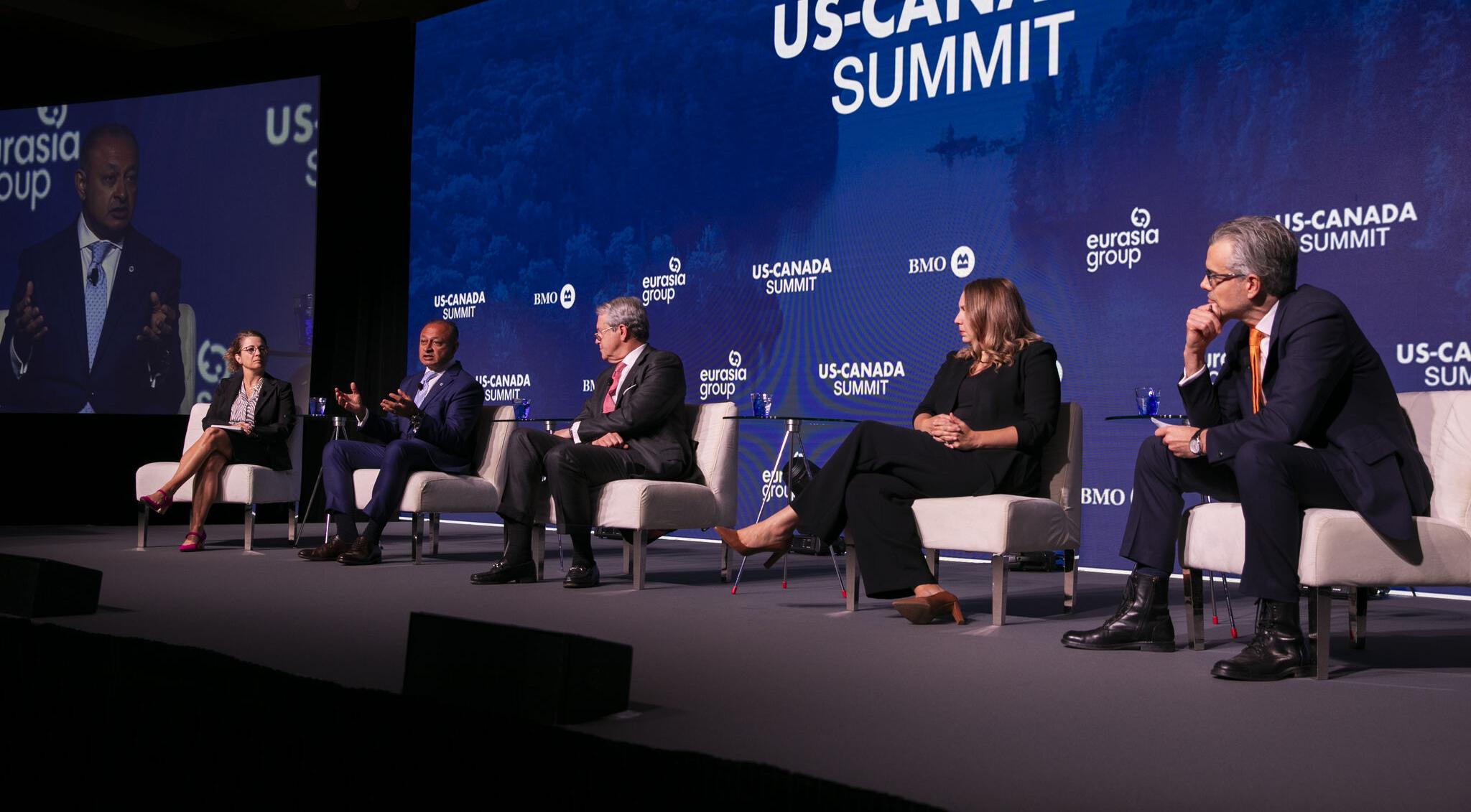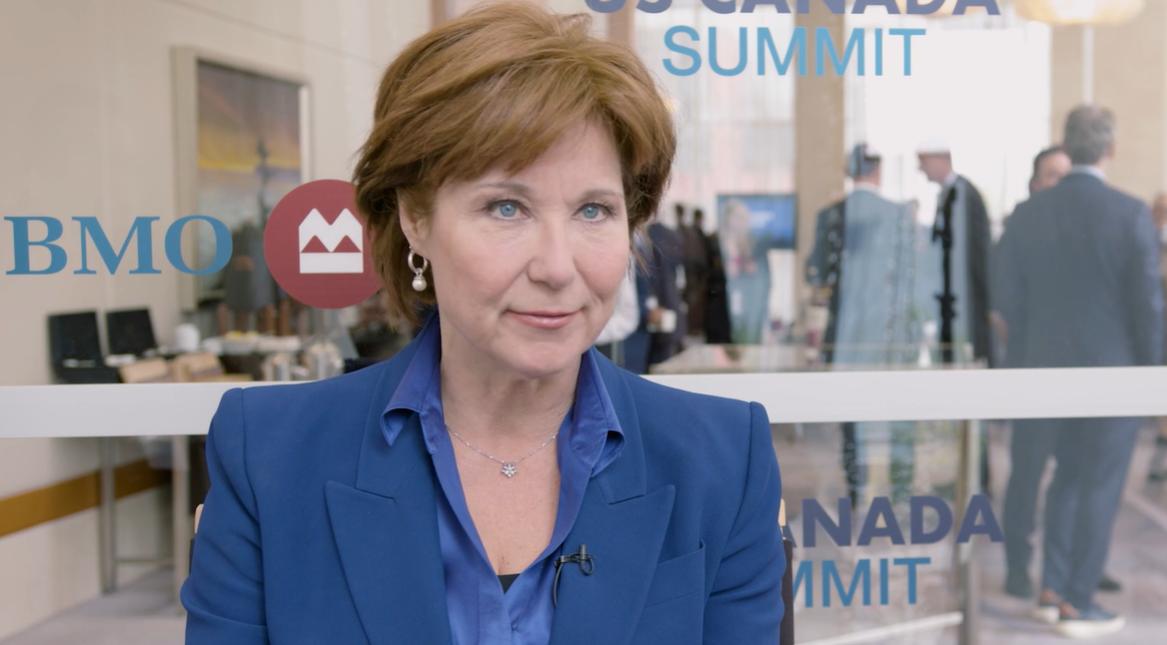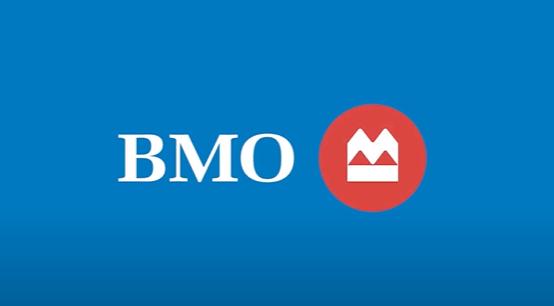
The US-Canada Partnership: North America’s Economic Outlook
-
bookmark
-
print
- Keywords:


The US-Canada economic relationship is responsible for millions of jobs and generates billions in trade.
Against this backdrop, the USMCA – the updated North American Free Trade Agreement – will become eligible for review in 2026. As Ian Bremmer, President of Eurasia Group, pointed out in his opening remarks at the second annual US-Canada Summit hosted by BMO and Eurasia Group, that’s relatively soon, especially when you consider no one knows for sure who will be leading those discussions in Washington and Ottawa.
This is no time for complacency. As Bremmer and Darryl White, Chief Executive Officer of BMO Financial Group, explained in a recent op-ed, “In the face of increasing geopolitical competition to North America’s advantage, business and political leaders have a responsibility to promote this partnership.”
Unpacking the political and economic opportunities and risks facing this relationship was the focus of Bulls, Bears, and Beavers – North America’s Economic Outlook, a panel discussion that I joined. The panel also included:
-
Elizabeth Baltzan, Senior Advisor, United States Trade Representative
-
Frances Donald, Global Chief Economist, Manulife Financial
-
Randal Quarles, Chairman, Cynosure Group and Former Vice Chair, the Federal Reserve
-
Hosted by Kevin Carmichael, Economics Columnist, The Logic
Here are some of the main takeaways from the conversation.
Pathways for the Canadian and U.S. economies
While the U.S. and Canada have effectively escaped recessions, the Canadian economy is nonetheless decelerating, at least over the short-term, an assessment made by Manulife’s Frances Donald during the discussion: “Canadians feel very much like they’re in a recession, even as economists say that’s not the case,” she said. Although Canada continues to add jobs, consumers are reining in spending. By contrast, U.S. consumers have been far more resilient.
A key difference is between the U.S. and Canadian housing markets. As Donald explained, Canadian homeowners are more sensitive to interest rate changes and face elevated home prices in major markets. Unlike Canada, where mortgage rates are typically renegotiated every five years, U.S. mortgages come with different types of home loans, including a 30-year fixed-rate option, offering consumers a little more stability.
Apart from differences in the housing market, Donald said Canada also lags about “40 years behind the U.S.” in terms of productivity. Still, the difference between the two countries cuts both ways, with Canada having the edge in interest costs and the national debt.
Over the medium term, we expect the two economies will get back in sync. When that process starts in the next few years, it could mean Canada will slightly outperform as interest rates decline and alleviate pressure on more debt-burdened Canadian households.
What’s next for interest rates?
The structural differences between the Canadian and U.S. economies could lead to differences in interest rate policy. While Canada has already started its rate-cutting cycle, the U.S. is likely to leave interest rates higher for longer, said Randal Quarles of Cynosure Group. “One of the issues is that the economy hasn’t slowed down enough,” said Quarles, a former Federal Reserve official, noting that U.S. businesses, like homeowners, haven’t had – or been willing – to refinance at higher rates.
However, that sentiment could shift as more debt securities are expected to mature over the next year, said Quarles. “That’s going to result in a significant increase in debt service costs.” All eyes are on where the Federal Reserve goes from here. At their most recent policy-setting meeting in June, the Fed indicated expectations of one rate cut in 2024 and four in 2025.
Quarles, who described himself as a “hawk” during his time on the committee, said he thinks a cut could come at the end of the year but adds he wouldn’t be surprised if there were none at all, given the way inflation is evolving.
Reviewing the USMCA
One theme that repeatedly came up during the summit was the importance of the USMCA, which is due for review in 2026.
As Elizabeth Baltzan with the United States Trade Representative’s office said, this review period will be about ensuring the terms of the deal are fit for purpose. Both Baltzan and Donald stressed the need to focus on the real economy when discussing trade policy.
Keeping that in focus could be critical to ensuring the North American economy is strong enough to withstand many of the geopolitical disruptions that have surfaced in recent years. “It used to be that the only right way to think about trade between nations is to take the barriers down,” she said. “With the pandemic and the Russian invasion of Ukraine, we’ve now seen the limitations of that approach.”
It’s imperative that our leaders work to minimize any disruption during this review period. I echo the comments Ian Bremmer made: “Cross border agreements can be easy targets in environments like this,” he said. “We can’t afford to let the extraordinary consumer benefits of our continental collaboration get lost in the midst. Private and public sector leaders must ensure that Main Street benefits from a deeper partnership in an increasingly complex world.”
Cautious optimism
Despite the differences between the Canadian and U.S. economies, I would say there’s cautious optimism among businesses. After coping with the challenges of the past few years, they’re now looking to return to growth. On both sides of the border, companies are considering onshoring, automation and other ways to improve productivity, and that takes investment.
Companies for the most part have done their part to get their balance sheets in order so they can make these investments now and in the future. They’ve been keeping an eye on expenses, while moderating inventory levels and managing their working capital. That patience and vigilance will be beneficial. When rates do come down, demand will go up, and these businesses need to be able to boost productivity and production. I think they are ready for it.
I spend a lot of time in both the U.S. and Canada talking with our clients, and in a world full of increasing competition and emerging world powers, the predictability of relations between our two countries puts us in an enviable position when it comes to economic growth, resulting in cautious optimism among businesses
Nadim Hirji:
At BMO, we've been leveraging our industry expertise and local market knowledge to help our customers grow their business and manage risk for over 200 years. We are a fully integrated North American commercial bank with major operations on both sides of the border. We're now one of the top five commercial banks in all of North America.
We take the long term view with our customers. We don't go for the quick win. Rather, we work with our customers, often over generations.
We partner closely with our capital markets and our wealth management colleagues to bring our entire suite of solutions to our customers. To our customers, thank you so much for your business. And to prospective customers looking to grow throughout North America, let us know how we can help you. Thank you.
Nadim Hirji is responsible for the strategic growth and leadership of BMO Commercial Bank, a dedicated team of over 5,000 engaged team members committed to driving …(..)
View Full Profile >The US-Canada economic relationship is responsible for millions of jobs and generates billions in trade.
Against this backdrop, the USMCA – the updated North American Free Trade Agreement – will become eligible for review in 2026. As Ian Bremmer, President of Eurasia Group, pointed out in his opening remarks at the second annual US-Canada Summit hosted by BMO and Eurasia Group, that’s relatively soon, especially when you consider no one knows for sure who will be leading those discussions in Washington and Ottawa.
This is no time for complacency. As Bremmer and Darryl White, Chief Executive Officer of BMO Financial Group, explained in a recent op-ed, “In the face of increasing geopolitical competition to North America’s advantage, business and political leaders have a responsibility to promote this partnership.”
Unpacking the political and economic opportunities and risks facing this relationship was the focus of Bulls, Bears, and Beavers – North America’s Economic Outlook, a panel discussion that I joined. The panel also included:
-
Elizabeth Baltzan, Senior Advisor, United States Trade Representative
-
Frances Donald, Global Chief Economist, Manulife Financial
-
Randal Quarles, Chairman, Cynosure Group and Former Vice Chair, the Federal Reserve
-
Hosted by Kevin Carmichael, Economics Columnist, The Logic
Here are some of the main takeaways from the conversation.
Pathways for the Canadian and U.S. economies
While the U.S. and Canada have effectively escaped recessions, the Canadian economy is nonetheless decelerating, at least over the short-term, an assessment made by Manulife’s Frances Donald during the discussion: “Canadians feel very much like they’re in a recession, even as economists say that’s not the case,” she said. Although Canada continues to add jobs, consumers are reining in spending. By contrast, U.S. consumers have been far more resilient.
A key difference is between the U.S. and Canadian housing markets. As Donald explained, Canadian homeowners are more sensitive to interest rate changes and face elevated home prices in major markets. Unlike Canada, where mortgage rates are typically renegotiated every five years, U.S. mortgages come with different types of home loans, including a 30-year fixed-rate option, offering consumers a little more stability.
Apart from differences in the housing market, Donald said Canada also lags about “40 years behind the U.S.” in terms of productivity. Still, the difference between the two countries cuts both ways, with Canada having the edge in interest costs and the national debt.
Over the medium term, we expect the two economies will get back in sync. When that process starts in the next few years, it could mean Canada will slightly outperform as interest rates decline and alleviate pressure on more debt-burdened Canadian households.
What’s next for interest rates?
The structural differences between the Canadian and U.S. economies could lead to differences in interest rate policy. While Canada has already started its rate-cutting cycle, the U.S. is likely to leave interest rates higher for longer, said Randal Quarles of Cynosure Group. “One of the issues is that the economy hasn’t slowed down enough,” said Quarles, a former Federal Reserve official, noting that U.S. businesses, like homeowners, haven’t had – or been willing – to refinance at higher rates.
However, that sentiment could shift as more debt securities are expected to mature over the next year, said Quarles. “That’s going to result in a significant increase in debt service costs.” All eyes are on where the Federal Reserve goes from here. At their most recent policy-setting meeting in June, the Fed indicated expectations of one rate cut in 2024 and four in 2025.
Quarles, who described himself as a “hawk” during his time on the committee, said he thinks a cut could come at the end of the year but adds he wouldn’t be surprised if there were none at all, given the way inflation is evolving.
Reviewing the USMCA
One theme that repeatedly came up during the summit was the importance of the USMCA, which is due for review in 2026.
As Elizabeth Baltzan with the United States Trade Representative’s office said, this review period will be about ensuring the terms of the deal are fit for purpose. Both Baltzan and Donald stressed the need to focus on the real economy when discussing trade policy.
Keeping that in focus could be critical to ensuring the North American economy is strong enough to withstand many of the geopolitical disruptions that have surfaced in recent years. “It used to be that the only right way to think about trade between nations is to take the barriers down,” she said. “With the pandemic and the Russian invasion of Ukraine, we’ve now seen the limitations of that approach.”
It’s imperative that our leaders work to minimize any disruption during this review period. I echo the comments Ian Bremmer made: “Cross border agreements can be easy targets in environments like this,” he said. “We can’t afford to let the extraordinary consumer benefits of our continental collaboration get lost in the midst. Private and public sector leaders must ensure that Main Street benefits from a deeper partnership in an increasingly complex world.”
Cautious optimism
Despite the differences between the Canadian and U.S. economies, I would say there’s cautious optimism among businesses. After coping with the challenges of the past few years, they’re now looking to return to growth. On both sides of the border, companies are considering onshoring, automation and other ways to improve productivity, and that takes investment.
Companies for the most part have done their part to get their balance sheets in order so they can make these investments now and in the future. They’ve been keeping an eye on expenses, while moderating inventory levels and managing their working capital. That patience and vigilance will be beneficial. When rates do come down, demand will go up, and these businesses need to be able to boost productivity and production. I think they are ready for it.
I spend a lot of time in both the U.S. and Canada talking with our clients, and in a world full of increasing competition and emerging world powers, the predictability of relations between our two countries puts us in an enviable position when it comes to economic growth, resulting in cautious optimism among businesses
2024 US-Canada Summit
PART 1
Darryl White & Ian Bremmer on the Importance of the US-Canada Relationship
Darryl White | June 24, 2024 | Business Strategy, Doing Business In The U.S

Darryl White, CEO of BMO Financial Group, and Ian Bremmer, President and Founder of Eurasia Group and GZERO Media sat down to discuss the “Nort…
PART 2
Top Leaders Speak to the North American Advantage at the US-Canada Summit
June 24, 2024 | Business Strategy, Doing Business In The U.S

During the 2024 US-Canada Summit that we hosted with Eurasia Group, we sat down with top leaders to discuss the importance of the US-Canad…
PART 4
How Private Equity is Adapting to Shifting Market Dynamics
Carrie Cook | June 24, 2024 | Business Strategy

Private equity investors are cautiously optimistic about North American markets after a tough past few years. Despite enduring a slew of macroeconomi…
PART 5
The Future of Work in North America: Reskilling and Upskilling
Mona Malone | June 24, 2024 | Business Strategy, Doing Business In The U.S

The nature, culture and meaning of work are undergoing a dynamic transformation: automation, digitization and the advent of generative artificial int…
PART 6
BMO Experts at the 2024 US-Canada Summit
June 24, 2024 | Business Strategy, Doing Business In The U.S

The 2024 US-Canada Summit featured senior decision makers from government, the private sector and society at large, and explored how to better unders…
PART 7
U.S.-Canada Summit Welcome Remarks
Darryl White | June 13, 2024 | Doing Business In The U.S

This is Year two of BMO’s partnership with the Eurasia Group, and I am pleased to welcome all of you here this morning to our U.S.–Canada…
PART 8
The Globe and Mail: For Canada and its U.S. trade relationship, complacency equals sleepwalking
Darryl White | June 06, 2024 | Doing Business Internationally, Business Strategy

This first published in The Globe and Mail on June 5, 2024, authored by Darryl White, CEO of BMO Financial Group and Ian Bremmer, President…
Related Insights
Tell us three simple things to
customize your experience






Banking products are subject to approval and are provided in Canada by Bank of Montreal, a CDIC Member.
BMO Commercial Bank is a trade name used in Canada by Bank of Montreal, a CDIC member.
Please note important disclosures for content produced by BMO Capital Markets. BMO Capital Markets Regulatory | BMOCMC Fixed Income Commentary Disclosure | BMOCMC FICC Macro Strategy Commentary Disclosure | Research Disclosure Statements
BMO Capital Markets is a trade name used by BMO Financial Group for the wholesale banking businesses of Bank of Montreal, BMO Bank N.A. (member FDIC), Bank of Montreal Europe p.l.c., and Bank of Montreal (China) Co. Ltd, the institutional broker dealer business of BMO Capital Markets Corp. (Member FINRA and SIPC) and the agency broker dealer business of Clearpool Execution Services, LLC (Member FINRA and SIPC) in the U.S. , and the institutional broker dealer businesses of BMO Nesbitt Burns Inc. (Member Canadian Investment Regulatory Organization and Member Canadian Investor Protection Fund) in Canada and Asia, Bank of Montreal Europe p.l.c. (authorised and regulated by the Central Bank of Ireland) in Europe and BMO Capital Markets Limited (authorised and regulated by the Financial Conduct Authority) in the UK and Australia and carbon credit origination, sustainability advisory services and environmental solutions provided by Bank of Montreal, BMO Radicle Inc., and Carbon Farmers Australia Pty Ltd. (ACN 136 799 221 AFSL 430135) in Australia. "Nesbitt Burns" is a registered trademark of BMO Nesbitt Burns Inc, used under license. "BMO Capital Markets" is a trademark of Bank of Montreal, used under license. "BMO (M-Bar roundel symbol)" is a registered trademark of Bank of Montreal, used under license.
® Registered trademark of Bank of Montreal in the United States, Canada and elsewhere.
™ Trademark of Bank of Montreal in the United States and Canada.
The material contained in articles posted on this website is intended as a general market commentary. The opinions, estimates and projections, if any, contained in these articles are those of the authors and may differ from those of other BMO Commercial Bank employees and affiliates. BMO Commercial Bank endeavors to ensure that the contents have been compiled or derived from sources that it believes to be reliable and which it believes contain information and opinions which are accurate and complete. However, the authors and BMO Commercial Bank take no responsibility for any errors or omissions and do not guarantee their accuracy or completeness. These articles are for informational purposes only.
Bank of Montreal and its affiliates do not provide tax, legal or accounting advice. This material has been prepared for informational purposes only, and is not intended to provide, and should not be relied on for, tax, legal or accounting advice. You should consult your own tax, legal and accounting advisors before engaging in any transaction.
Third party web sites may have privacy and security policies different from BMO. Links to other web sites do not imply the endorsement or approval of such web sites. Please review the privacy and security policies of web sites reached through links from BMO web sites.
Please note important disclosures for content produced by BMO Capital Markets. BMO Capital Markets Regulatory | BMOCMC Fixed Income Commentary Disclosure | BMOCMC FICC Macro Strategy Commentary Disclosure | Research Disclosure Statements





